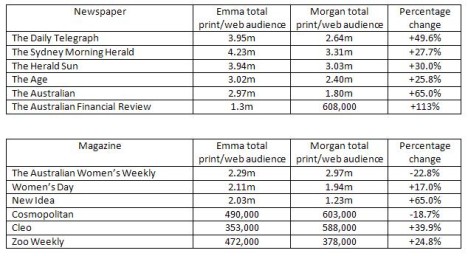Publishers’ new readership metric shows big growth in audiences compared to old measure
![]() The first set of data from the new readership metric Enhanced Media Metrics Australia (EMMA) has recorded a significant increase in the audience of many of Australia’s largest publishers compared with rival Roy Morgan Research.
The first set of data from the new readership metric Enhanced Media Metrics Australia (EMMA) has recorded a significant increase in the audience of many of Australia’s largest publishers compared with rival Roy Morgan Research.
EMMA – funded by Australia’s publishers – is a challenger to Morgan’s existing industry readership metric. EMMA provides readership data for print and digital platforms .
A comparison of the two by Mumbrella shows significant increases of between 25 per cent and 113 per cent in the estimated audiences of most mastheads belonging to publishers News Limited, Fairfax Media, Pacific Magazines and Bauer Media.



I don’t see the point in breaking out tablet and mobile from web – they are devices for digital consumption, not mediums in themselves.
Not surprised to see the SMH is now Australia’s most read newspaper across combined print/digital. You can just tell with the amount of shares there are on social media of Fairfax articles, plus the hundreds of reader comments that most of their articles generate. While News still dominates print, Fairfax’s big reach in digital reach puts it ahead overall. And even if these figures are exaggerated, the positioning of each masthead is likely to be accurate, otherwise News wouldn’t be championing EMMA so much.
I just didn’t think it would be possible for the News tabloids to generate big digital audiences. That type of content might be great for print but I don’t think it gels with digital audiences… as these figures show.
‘EMMA – funded by Australia’s publishers…’ publishes a bunch of stats the publishers love.
Does anyone actually believe them, though? Sydney’s population is 4.5 million. 85% of them read the Herald and the Telly… *bullshit*
Ex reader, do the words “independent audit” mean anything to you?
I love a good conspiracy theory. They inevitably pop up when someone’s long held world view is challenged and they’re not comfortable with change.
Who would have thought that surveying people in as close to real time as possible, plus fusing actual online readership data, would increase readership figures vs a long, boring conversation held once a week while filling in a paper diary?
Oh yeah…anyone with rational thought.
Deary me – does anyone actually believe this bulldust??
Good grief.
@Ricki – singing from the publisher song book. If anything, the Morgan data would overstate newspaper readership.
These figures are extraordinary – nearly 4 readers per circulated copy of a weekday newspaper? Does that include online? With household sizes shrinking and workplaces dominated by people reading online?
And surely the combined print/online metric is fairly meaningless.
@Anonymous
With a simple script running through a TOR browser I could deliver your site thousands of ‘readers’ per hour. With some serious servers and vpns I could make you the king of the internet.
Bloody, hell. I’m in the wrong business, think I’ll open an astroturf firm and help big content screw over adland more than it already does.
Also… up to 11 readers per copy???
Stu…how exactly do you figure that asking someone a question about what they read up to 6 days after the fact, would overstate readership? Please enlighten me.
Ricki, I remember exactly how many newspapers I read in the last 7 – none. Not that hard.
Ricki – if it’s an everyday activity (like reading a newspaper), you are more likely to say that you read it 6 days ago, even if you didn’t. It favours well-known brands and frequently read mastheads (like The Herald Sun for example) at the expense of smaller ones.
Oh sorry JD. I should have realised that your media consumption behaviour is a proxy for 23 million Australians regardless of who they are, what stage of life they’re in and where they live. My bad.
Does Ricki have any interests to declare? She sounds quite well informed…
I’m well informed because I’ve read the released information. I have previously worked for the newspaper industry but no longer. I have not seen any of the data prior to this release and have no vested interests. The industry of which I’m a part have been looking at this issue for years and I’ve had extensive experience with Morgan both as a user and a client.
My opinion is based on the data I’m looking at, same as everyone else, past experience with Morgan and the global credibility of Ipsos. Here’s an idea…perhaps the conspiracy theorists could also do some homework? I won’t hold my breath.
It doesn’t raise questions when a new methodology, delayed for years, funded and designed by publishers, suddenly finding hundreds of thousands of new readers in a medium that is clearly in decline?
If only the publishers put as much effort into their product and business model as they do into shooting the messenger, they might be in better shape.
@Ben, the markup supplied to browsers now frequently has a three level branch: normal browsers, mobile(phone) browsers and tablets. The explicit breakout helps people who do page design look at the metrics of which view predominates, and so decide which style issues to address. I know that phone/mobile view on tablet is a royal pain when you get badly sized images, and wasted layout because of a 640×480 tiny screen. Its quite different to view this stuff on a nexus 7 or iPad. And both are radically different to a PC/desktop browser in terms of back-end support for things like java, flash and javascript.
I know it might not make front-end sense, but I think it does make back-end sense to count it.